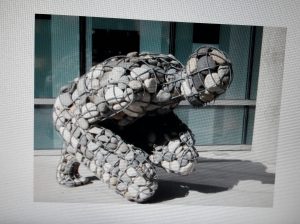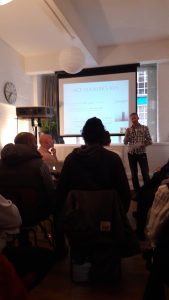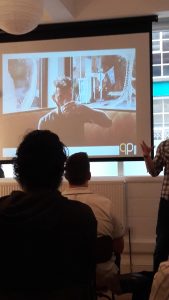“Whenever I think of Switzerland, my pelvis hurts!”
Urinating, intercourse, standing in a queue, stuck in an elevator, sitting at a desk at work, eating mayonnaise or even thinking of Switzerland – chronic pelvic pain syndrome (CPPS) does not discriminate. These are just some examples of triggers that have brought on the discomfort associated with pain in the pelvic region. Indeed a royal pain in the arse to have to contend with!
The usual outcome attributes of pain are known – protective behaviours, tension, avoidance, non-use of certain body parts and even loss of control of certain body parts (see smudging blog)…all of these factors compounding the pain experience with a loss of self-esteem, loss of control and poor self-image.
The community of lives affected by the distress and malfunction will extend to include partners, relatives, friends and colleagues. The pebble dropped into the pond ripples pervasively, profoundly and silently for reasons poorly understood. Karl Monahan’s seminar at Le Pub Scientifique at Le Beau Scrutton St. had clinicians and patients amongst the audience. Insights from his work and research were thoughtfully, interestingly and clearly shared in this presentation called ‘Male pelvic pain – a REAL pain in the arse’.
Prostatitis – ‘prostate’ + ‘itis’ (meaning inflammation) = inflammation of the prostate
For male pain sufferers with discomfort emanating from anywhere between the abdomen down to the inner thighs – loins, groins, perineum, pelvic floor – their experience of the medical profession is that the ‘norm’ is to be pigeon holed with ‘prostatitis’ as a generic diagnosis. The ramification is that mostly the diagnosis is incorrect, misleading and unhelpful. Furthermore the ‘norm’ is so extensive that it becomes an artificial barrier. The barrier is further perpetuated by internet searches, forums and ‘woolly’ information as the subject is still very much taboo in society. It’s not so easy for men to discuss issues so openly.
The effect of mis-diagnosis is incorrect treatment and no resolution to the ailment.
The ‘go to’ remedy for prostatitis is anti-biotics despite it being known since the 1960s it has no better outcome than a placebo. In fact, don’t be surprised to be advised a long term (years) continual re-administration of the drug as it is a struggle to find practitioners willing to perform the 4 Glass prostate test. Research has shown that most practitioners would willingly prefer to never treat or deal with the test…offering them the option of administering anti-biotics is the preferred method of treating anyone with symptoms that could be related. It’s a quick fix.
Incidents of bacterial infection causing prostatitis is very low. Most males (and females) carry bacteria in their bodies without any painful effects. Therefore administering anti-biotics is unlikely to serve any practical purpose.
The diagnosis of ‘prostatitis’ and bacterial infection can have traumatic effects on individuals. Is there a threat of passing the infection onto a partner? Has there been sexual promiscuity? Alternatively is the pain caused by sexual trauma? Should they stop activities?
A taboo subject, a support structure not capable of accurate diagnosis, incorrect treatment and personal insecurity all impede the healing process.
Knowledge and understanding are vital elements to managing and coping with pain. The good news is that pelvic pain follows the same principles as any modern ‘Pain Science’. Our brains interpretation of danger feedback is an increase in the pain response. Finding where the danger is lurking is multi-factorial and complex…it is understood to be a mixture of social, psychological and biological inputs. Why the threat level should increase from thinking about Switzerland, eating mayonnaise or sexual intercourse indicates how ‘personal’ each of our pain responses are.
Neuro-plasticity (see blog on smudging) explains how movement patterns become coded within the brain. Our ‘brain-space’ affords mapping space for various limbs. Our hands for example are capable of great control which requires more ‘real-estate’ in the brain. Thoughts, memories, actions, movements – all direct stimuli will leave a trace in our brains.
Pain memories can become overly enlarged simply by re-calling them or performing the actions repeatedly or not confronting them in the first instance. The legacy of repeated activation is called ‘plasticity’ – the formation, development and growth to particular sensitivities.
Resolution will use the same framework – plasticity: the body’s ability to adapt and change. A reversal can be affected with persistence, effort and careful management. Don’t expect a quick or straight forward resolution – people are complex. The answers are unknown and can be hidden in many places but there is hope…people do overcome pain. The key to unlocking the pain syndrome is as personal as the pain experience is individual. Finding the knowledge and speaking to professionals who understand the subject will help you start the journey to re-gain control.
To find out more of the techniques available for pain sufferers or for teachers wishing to learn more please contact:
Karl Monahan – www.thepelvicpainclinic.co.uk The Pelvic Pain Clinic
Tim Beames – www.painandperformance.com Pain and Performance
Or you can contact myself directly mal@lebeauvelo.co.uk




